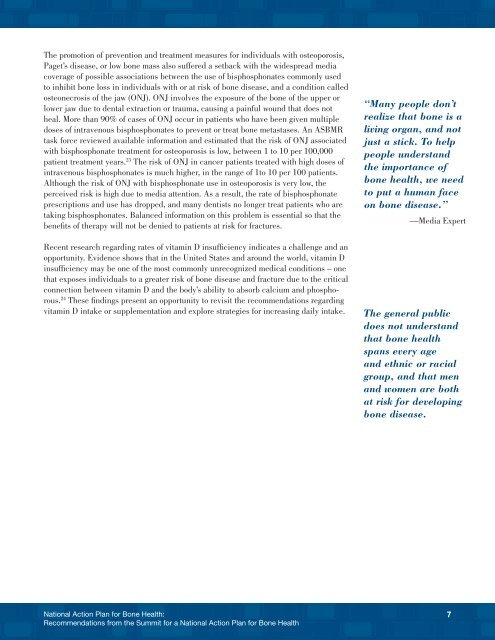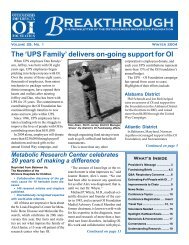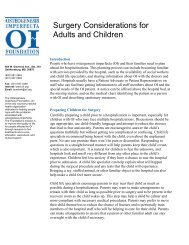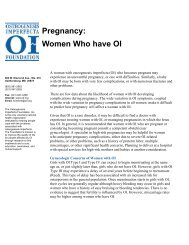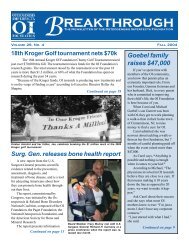National Action Plan for Bone Health - Osteogenesis Imperfecta ...
National Action Plan for Bone Health - Osteogenesis Imperfecta ...
National Action Plan for Bone Health - Osteogenesis Imperfecta ...
Create successful ePaper yourself
Turn your PDF publications into a flip-book with our unique Google optimized e-Paper software.
The promotion of prevention and treatment measures <strong>for</strong> individuals with osteoporosis,<br />
Paget’s disease, or low bone mass also suffered a setback with the widespread media<br />
coverage of possible associations between the use of bisphosphonates commonly used<br />
to inhibit bone loss in individuals with or at risk of bone disease, and a condition called<br />
osteonecrosis of the jaw (ONJ). ONJ involves the exposure of the bone of the upper or<br />
lower jaw due to dental extraction or trauma, causing a painful wound that does not<br />
heal. More than 90% of cases of ONJ occur in patients who have been given multiple<br />
doses of intravenous bisphosphonates to prevent or treat bone metastases. An ASBMR<br />
task <strong>for</strong>ce reviewed available in<strong>for</strong>mation and estimated that the risk of ONJ associated<br />
with bisphosphonate treatment <strong>for</strong> osteoporosis is low, between 1 to 10 per 100,000<br />
patient treatment years. 23 The risk of ONJ in cancer patients treated with high doses of<br />
intravenous bisphosphonates is much higher, in the range of 1to 10 per 100 patients.<br />
Although the risk of ONJ with bisphosphonate use in osteoporosis is very low, the<br />
perceived risk is high due to media attention. As a result, the rate of bisphosphonate<br />
prescriptions and use has dropped, and many dentists no longer treat patients who are<br />
taking bisphosphonates. Balanced in<strong>for</strong>mation on this problem is essential so that the<br />
benefits of therapy will not be denied to patients at risk <strong>for</strong> fractures.<br />
Recent research regarding rates of vitamin D insufficiency indicates a challenge and an<br />
opportunity. Evidence shows that in the United States and around the world, vitamin D<br />
insufficiency may be one of the most commonly unrecognized medical conditions – one<br />
that exposes individuals to a greater risk of bone disease and fracture due to the critical<br />
connection between vitamin D and the body’s ability to absorb calcium and phosphorous.<br />
24 These findings present an opportunity to revisit the recommendations regarding<br />
vitamin D intake or supplementation and explore strategies <strong>for</strong> increasing daily intake.<br />
“Many people don’t<br />
realize that bone is a<br />
living organ, and not<br />
just a stick. To help<br />
people understand<br />
the importance of<br />
bone health, we need<br />
to put a human face<br />
on bone disease.”<br />
—Media Expert<br />
The general public<br />
does not understand<br />
that bone health<br />
spans every age<br />
and ethnic or racial<br />
group, and that men<br />
and women are both<br />
at risk <strong>for</strong> developing<br />
bone disease.<br />
<strong>National</strong> <strong>Action</strong> <strong>Plan</strong> <strong>for</strong> <strong>Bone</strong> <strong>Health</strong>:<br />
Recommendations from the Summit <strong>for</strong> a <strong>National</strong> <strong>Action</strong> <strong>Plan</strong> <strong>for</strong> <strong>Bone</strong> <strong>Health</strong><br />
7


